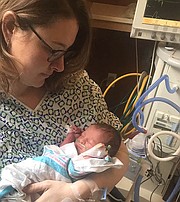For the second time, the Cleveland Clinic has delivered a baby from a uterus that was transplanted from a deceased donor.
The transplant and birth are part of an on-going clinical trial – Uterine Transplantation for the Treatment of Uterine Factor Infertility – at Cleveland Clinic, offering hope to women worldwide who are unable to have a baby due to uterine factor infertility. An estimated 1 in 500 women of childbearing age worldwide is affected by the irreversible condition.
Cleveland Clinic’s transplant surgeon, Dr Cristiano Quintini is the principal investor for the clinical trial.
In March, the research team – comprised of specialists in transplant surgery, obstetrics and gynaecology, fertility, neonatology, bioethics, psychiatry, nursing, anesthesiology, infectious disease, interventional radiology, pharmacy, patient advocacy and social work – welcomed a boy via caesarean section. The uterus, from a deceased donor, was transplanted in early 2019. In late 2019, Michelle, the mother, who is 31, became pregnant through in vitro fertilization.
Michelle was 16 when doctors discovered that she had no uterus.
“One of my dreams was being able to (give birth) one day, but I didn’t think it would ever be possible,” she said.
But thanks to the Cleveland Clinic's transplant programme Michelle and her husband Rich were able to fulfil their dream of having a baby.
The couple discussed applying to the programme and quickly did so in 2016. Thus began a four-year odyssey, starting with numerous rounds of interviews, testing and meetings with representatives of the team.
Once approved, Michelle underwent a rigorous process of ovarian stimulation, egg retrieval and in vitro fertilization – harvesting and freezing fertilized eggs to be implanted once she got a uterus transplant. The team was able to harvest several viable embryos.
With that critical step complete, the real waiting began. Unlike some uterine transplant trials, which use living donors, the Cleveland Clinic programme only includes deceased-donor uteruses. With her hospital bag packed, and on the shelf, Michelle and Rich experienced three false alarms – in February, September and December 2018. In each case, they were notified that a donor uterus was available and to be prepared to come to Cleveland Clinic immediately. However, in each case, the donor uterus did not prove to be an ideal match and the transplant was called off.
“Donor selection is hugely important and the first step to a successful transplant. The uterus is a small organ, with very little blood flow, and for it to remain viable, the blood supply has to be adequate. It’s a real challenge, because about 20 to 25 percent of all transplants are lost because of a lack of (proper) blood flow after the operation,” said Dr Quintini.
In late January 2019, Michelle received the hopeful news she had long been awaiting. Her care team identified a uterus that was a good match. The transplant would move forward. On a Monday evening that same month, the transplant began. The surgery finished 14 hours later, into the next morning. While the transplant was successful, Michelle endured a few complications.
Not long afterwards, however, Michelle knew for sure her new organ was working. “At age 31, I had my first period. That’s something I never thought I would experience!”
In July 2019, after regular follow-up tests to make sure blood was flowing freely to her implanted uterus and the use of immunosuppressive medications was effectively helping her body adjust, Michelle began the next phase – transferring one embryo into her uterus.
Soon after Michelle underwent that procedure, she bought a home pregnancy test, “because I wanted to experience what it felt like to learn you’re pregnant, like anyone else.” To her surprise, the test was positive – and she excitedly texted a disbelieving Rich: “I’m pregnant!”
Throughout her pregnancy, which included a daily bout with morning sickness, Cleveland Clinic maternal/foetal medicine specialists monitored her condition closely. “Michelle experienced some hypertension, for which she was on medication. And we wanted to avoid complications such as preeclampsia (high blood pressure),” said Dr Uma Perni, who specialises in high-risk pregnancies.
Delivered by C-section, which is required for a mother with a transplanted uterus, Cole “came out screaming,” said Dr Perni. “Michelle had a beautiful delivery and a healthy baby boy.”
Cleveland Clinic transplant surgeon Dr Andreas Tzakis spearheaded bringing the uterus transplantation, which was the first in the United States and one of the first in the world, to the Cleveland Clinic in 2015.
Since the Cleveland Clinic began the clinical trial, the team has completed eight uterus transplants; six transplants were successful and two resulted in hysterectomies soon after transplantation.
The aim is to enrol ten women between the ages of 21 and 39 years old. Unlike similar research efforts in the US, Cleveland Clinic’s protocol calls for the transplanted uterus to come from a deceased donor in order to eliminate risk to a healthy, living donor.
• For more information about Cleveland Clinic’s uterine transplant programme, look up www.clevelandclinic.org/lp/uterus-transplant/index.html





Comments
Use the comment form below to begin a discussion about this content.
Sign in to comment
Or login with:
OpenID